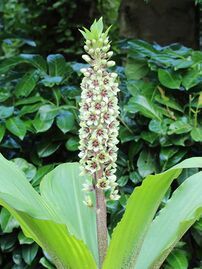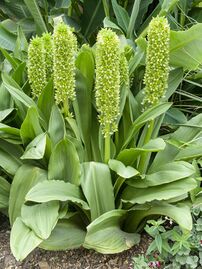Biology:Eucomis
| Eucomis | |
|---|---|

| |
| Eucomis autumnalis | |
| Scientific classification | |
| Kingdom: | Plantae |
| Clade: | Tracheophytes |
| Clade: | Angiosperms |
| Clade: | Monocots |
| Order: | Asparagales |
| Family: | Asparagaceae |
| Subfamily: | Scilloideae |
| Genus: | Eucomis L'Hér. |
| Type species | |
| Eucomis regia (L.) L'Hér.[1]
| |
| Synonyms[2] | |
| |
Eucomis is a genus of flowering plants in the family Asparagaceae, subfamily Scilloideae, native to southern Africa.[2] Most species of this genus are commonly referred to as pineapple flowers or pineapple lilies. They are bulbous perennials with basal rosettes of leaves and stout stems covered in star-shaped flowers with a tuft of green bracts at the top, superficially resembling a pineapple – hence the common names.[3]
Taxonomy
The genus Eucomis was first published by Charles L'Héritier in 1789.[2][4] The name Eucomis is of Greek origin, eu- meaning "pleasing" and kome "hair of the head",[5] thus referring to the tuft of leaf-like bracts that crown the inflorescence of the species in this genus. The name was first used by Daniel Solander, who decided that Linnaeus's Fritillaria regia should be placed in a separate genus. However, Solander died before publishing the name, and was not mentioned by L'Héritier in his 1789 publication.[6] Initially, three species were placed in Eucomis: E. regia, E. nana and E. punctata.[4] (The last two are now synonyms of E. regia[7] and E. comosa[8] respectively.)
Classification
Eucomis is placed in the subfamily Scilloideae of the family Asparagaceae by those who use the APG system of plant classification,[9] and in the family Hyacinthaceae by those who use more narrowly defined families.[10] Using the subfamily Scilloideae, Eucomis is placed in the tribe Hyacintheae, subtribe Massoniinae, along with such genera as Lachenalia, Ledebouria, Massonia and Veltheimia.[11]
The species can be divided into two groups. One consists of seven mainly short, diploid species with 2n = 2x = 30 chromosomes: E. amaryllidifolia, E. bicolor, E. grimshawii, E. regia, E. schijffii, E. vandermerwei and E. zambesiaca. The other consists of five mainly larger, tetraploid species with 2n = 4x = 60 chromosomes: E. autumnalis, E. comosa, E. humilis, E. montana and E. pallidiflora.[12] The ploidy of E. sonnetteana is not known.[13]
Species
The genus includes 13 accepted species.[2]
- Eucomis amaryllidifolia Baker – South Africa
- Eucomis autumnalis (Mill.) Chitt. (syn. E. undulata Aiton) – South Africa, Malawi, Zimbabwe, Botswana, Lesotho, Eswatini
- Eucomis bicolor Baker – South Africa, Lesotho
- Eucomis comosa (Houtt.) Wehrh. (syns. E. punctata L'Hér., E. striata (Ker Gawl.) W.T.Aiton) – South Africa
- Eucomis grimshawii G.D.Duncan & Zonn. – South Africa
- Eucomis humilis Baker – South Africa, Lesotho
- Eucomis montana Compton – South Africa, Eswatini
- Eucomis pallidiflora Baker (syn. E. pole-evansii N.E.Br.) South Africa, Lesotho, Eswatini
- Eucomis regia (L.) L'Hér. – South Africa
- Eucomis schijffii Reyneke – South Africa, Lesotho
- Eucomis sonnetteana N.R.Crouch, Mart.-Azorín & J.E.Burrows – Mpumalanga
- Eucomis vandermerwei Verd. – Mpumalanga
- Eucomis zambesiaca Baker – Malawi, Zimbabwe, Limpopo
Distribution and habitat
Eucomis is native to South Africa , Botswana, Lesotho, Eswatini, Zimbabwe and Malawi. Species can be found in grassland, forest, swamps and on river banks, but are absent from the drier regions.[14] The smaller species are more often found at higher elevations, on hilltops or other exposed places; the larger species favour less exposed habitats, such as damp gulleys and streamsides.[6]
Cultivation
Eucomis species are cultivated as ornamental plants. Most of the summer-flowering species will tolerate frost down to −5 to −10 °C (23 to 14 °F) when dormant in winter, provided they are kept dry. They flower best if given both sun exposure and moisture in summer.[6][14] Eucomis regia grows in winter and flowers in early spring. It needs greenhouse cultivation in regions that, like Britain, have a maritime rather than a Mediterranean climate.[6]
See also
- List of plants known as lily
References
- ↑ "Tropicos – Eucomis". Missouri Botanical Garden. https://tropicos.org/name/40006689.
- ↑ 2.0 2.1 2.2 2.3 "POWO – Eucomis". Royal Botanic Gardens, Kew. https://powo.science.kew.org/taxon/urn:lsid:ipni.org:names:24249-1.
- ↑ RHS A-Z encyclopedia of garden plants. United Kingdom: Dorling Kindersley. 2008. pp. 1136. ISBN 978-1405332965.
- ↑ 4.0 4.1 L'Héritier de Brutelle, Charles Louis (1789), "Eucomis", Sertum Anglicum, seu, Plantae rariores quae in hortis juxta Londinum : imprimis in horto regio Kewensi excoluntur, ab anno 1786 ad annum 1787 observata, Paris: Didot, p. 11, https://biodiversitylibrary.org/page/11832429, retrieved 2018-10-07
- ↑ Coombes, Allen J. (1994). Dictionary of Plant Names. London: Hamlyn Books. p. 70. ISBN 978-0-600-58187-1.
- ↑ 6.0 6.1 6.2 6.3 Compton, James (1990). "Eucomis L'Heritier". The Plantsman 12 (3): 129–139.
- ↑ "POWO – Eucomis nana". Royal Botanic Gardens, Kew. https://powo.science.kew.org/taxon/urn:lsid:ipni.org:names:534997-1.
- ↑ "POWO – Eucomis punctata". Royal Botanic Gardens, Kew. https://powo.science.kew.org/taxon/urn:lsid:ipni.org:names:535001-1.
- ↑ Chase, M.W.; Reveal, J.L.; Fay, M.F. (2009). "A subfamilial classification for the expanded asparagalean families Amaryllidaceae, Asparagaceae and Xanthorrhoeaceae". Botanical Journal of the Linnean Society 161 (2): 132–136. doi:10.1111/j.1095-8339.2009.00999.x.
- ↑ Manning, J.C.; Goldblatt, P.; Fay, M.F. (2004). "A revised generic synopsis of Hyacintheaceae in sub-Saharan Africa, based on molecular evidence, including new combinations and the new tribe Pseudoprospereae". Edinburgh Journal of Botany 60 (3): 533–568. doi:10.1017/S0960428603000404.
- ↑ Pfosser, M.; Wetschnig, W.; Ungar, S.; Prenner, G. (2004). "Phylogenetic relationships among genera of Massonieae (Hyacinthaceae) inferred from plastid DNA and seed morphology". Journal of Plant Research 116 (2): 115–132. doi:10.1007/s10265-003-0076-8. PMID 12736783. https://www.researchgate.net/publication/10768652.
- ↑ Zonneveld, B.J.M.; Duncan, G.D. (2010). "Genome sizes of Eucomis L'Hér. (Hyacinthaceae) and a description of the new species Eucomis grimshawii G.D.Duncan & Zonneveld". Plant Systematics and Evolution 284 (1–2): 99–109. doi:10.1007/s00606-009-0236-y.
- ↑ Crouch, Neil R.; Martínez-Azorín, Mario; Lötter, Mervyn C.; Burrows, John E.; Condy, Gillian (June 2019). "Euomis sonnetteana". Flowering Plants of Africa 66: 46-55. https://rua.ua.es/dspace/bitstream/10045/96282/1/2019_Crouch_etal_Flowering_Plants_of_Africa.pdf#page=13. Retrieved 3 October 2022.
- ↑ 14.0 14.1 "PlantZAfrica – Eucomis autumnalis". South African National Biodiversity Institute. http://pza.sanbi.org/eucomis-autumnalis.
Bibliography
- Crouch, Neil R. (2010). "An adaptation of Reyneke's key to the genus Eucomis". PlantLife (39 & 40): 45–52. http://plantlife.co.za/wp-content/uploads/2010/07/An-adaptation-of-Reyneke%E2%80%99s-key-to-the-genus-Eucomis-.pdf. Retrieved 2013-08-21.
- Duncan, Graham (April 2013). "755. Eucomis amaryllidifolia". Curtis's Botanical Magazine 30 (1): 49–55. doi:10.1111/curt.12016.
- Duncan, Graham (2007). "Lesser-known Eucomis". The Plantsman. New Series 6 (2): 98–103.
- Duncan, Graham (October 2011). "712. Eucomis vandermerwei". Curtis's Botanical Magazine 28 (3): 176–189. doi:10.1111/j.1467-8748.2011.01744.x.
External links
- Pacific bulb society wiki [1]
Wikidata ☰ Q2706641 entry
 |









